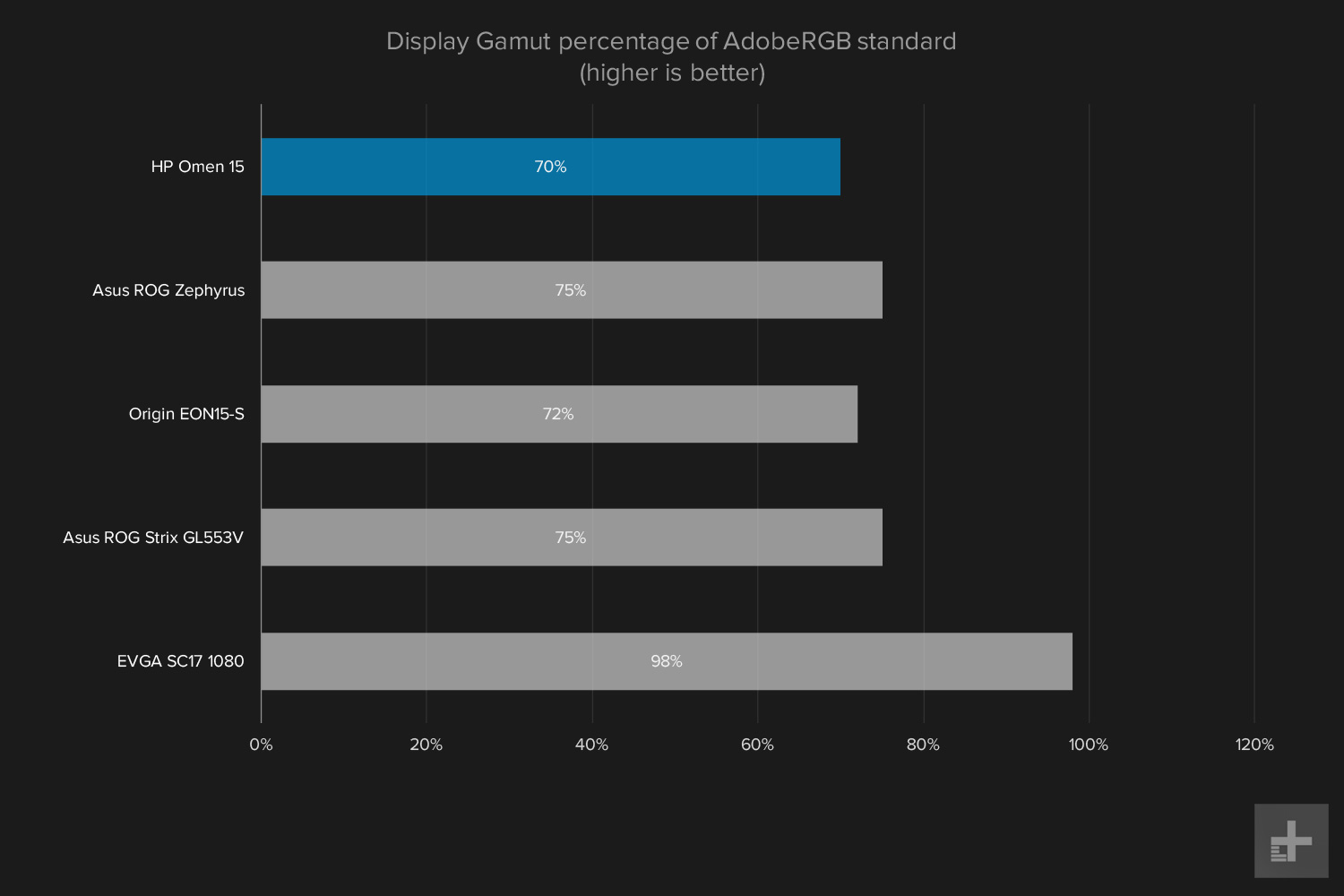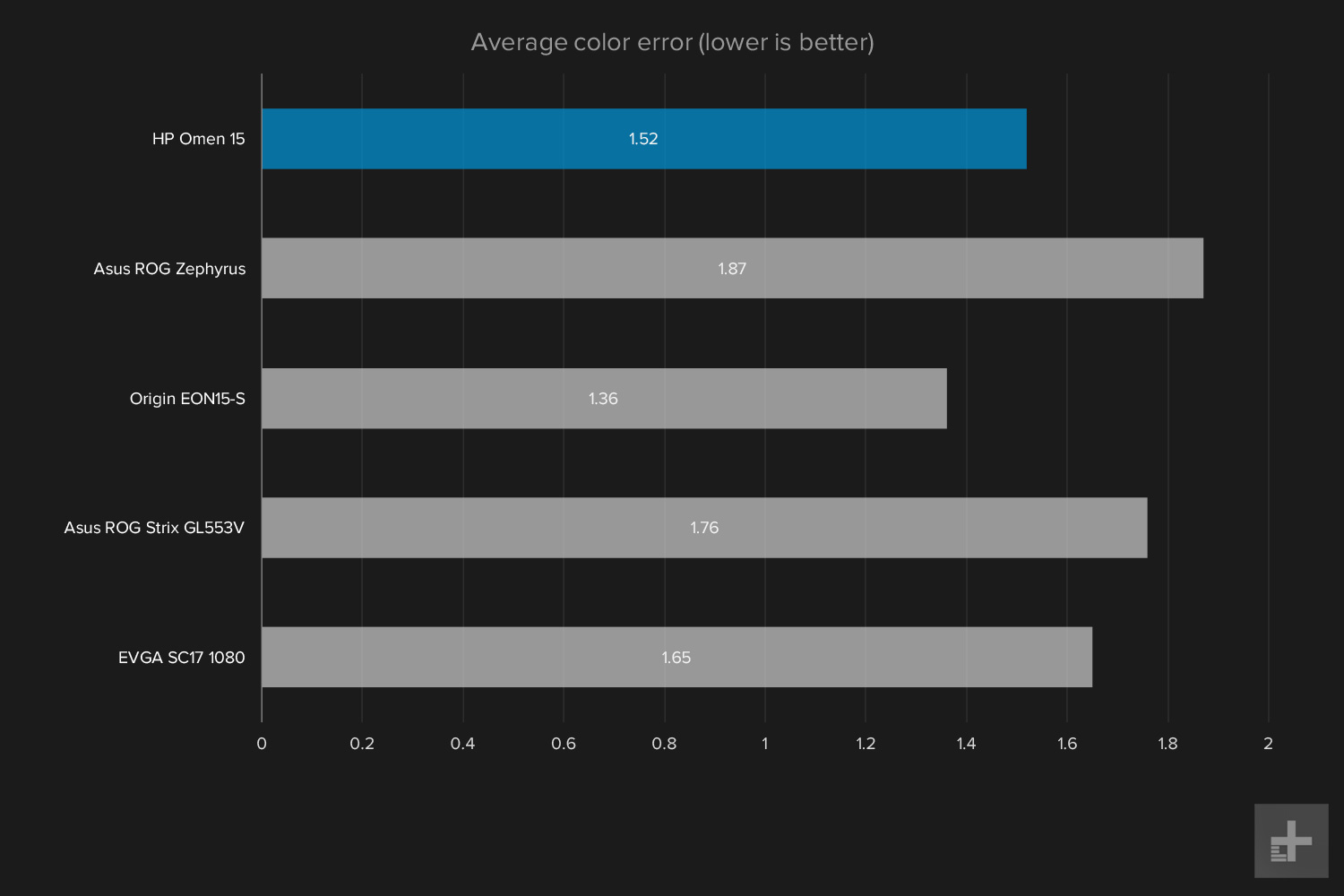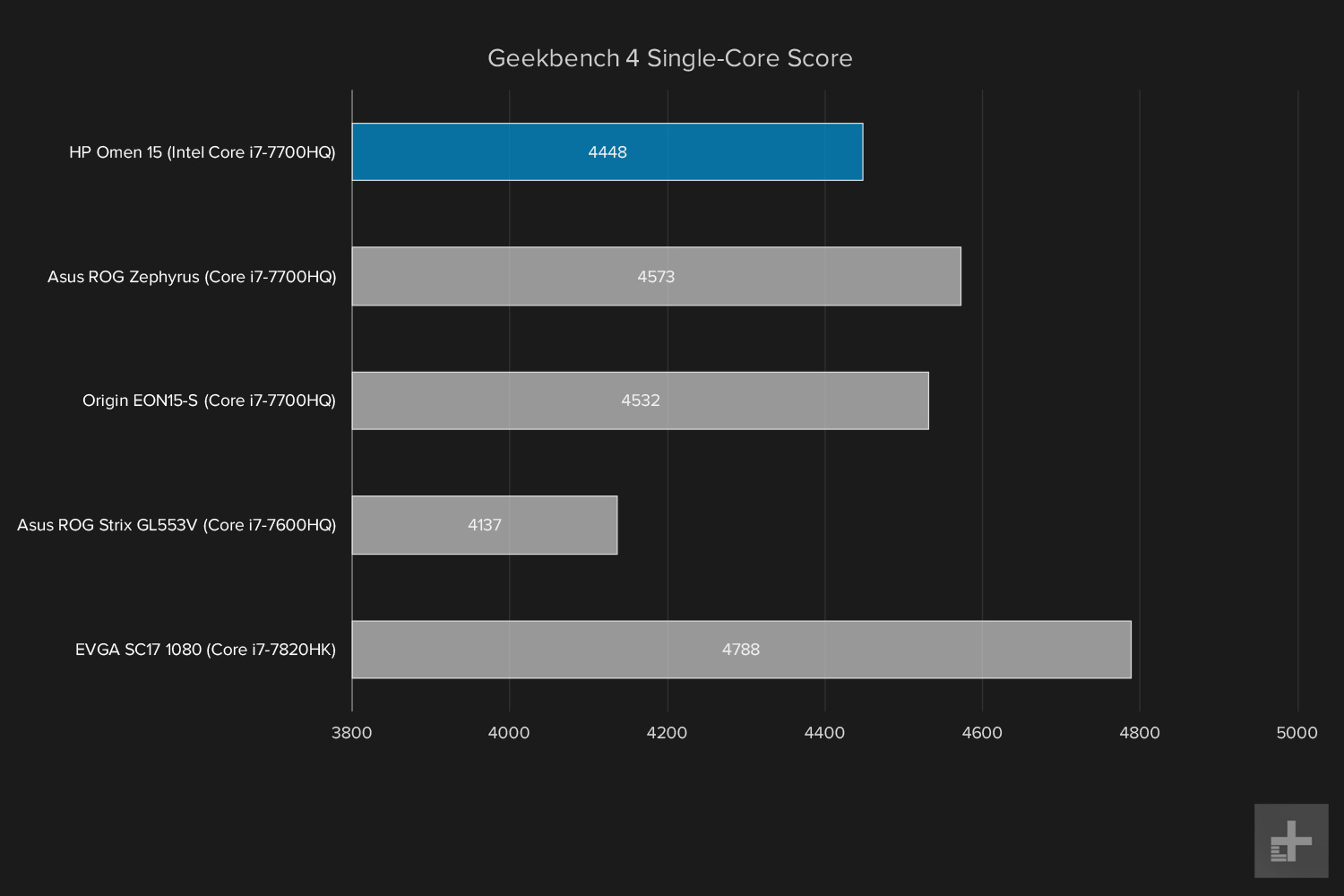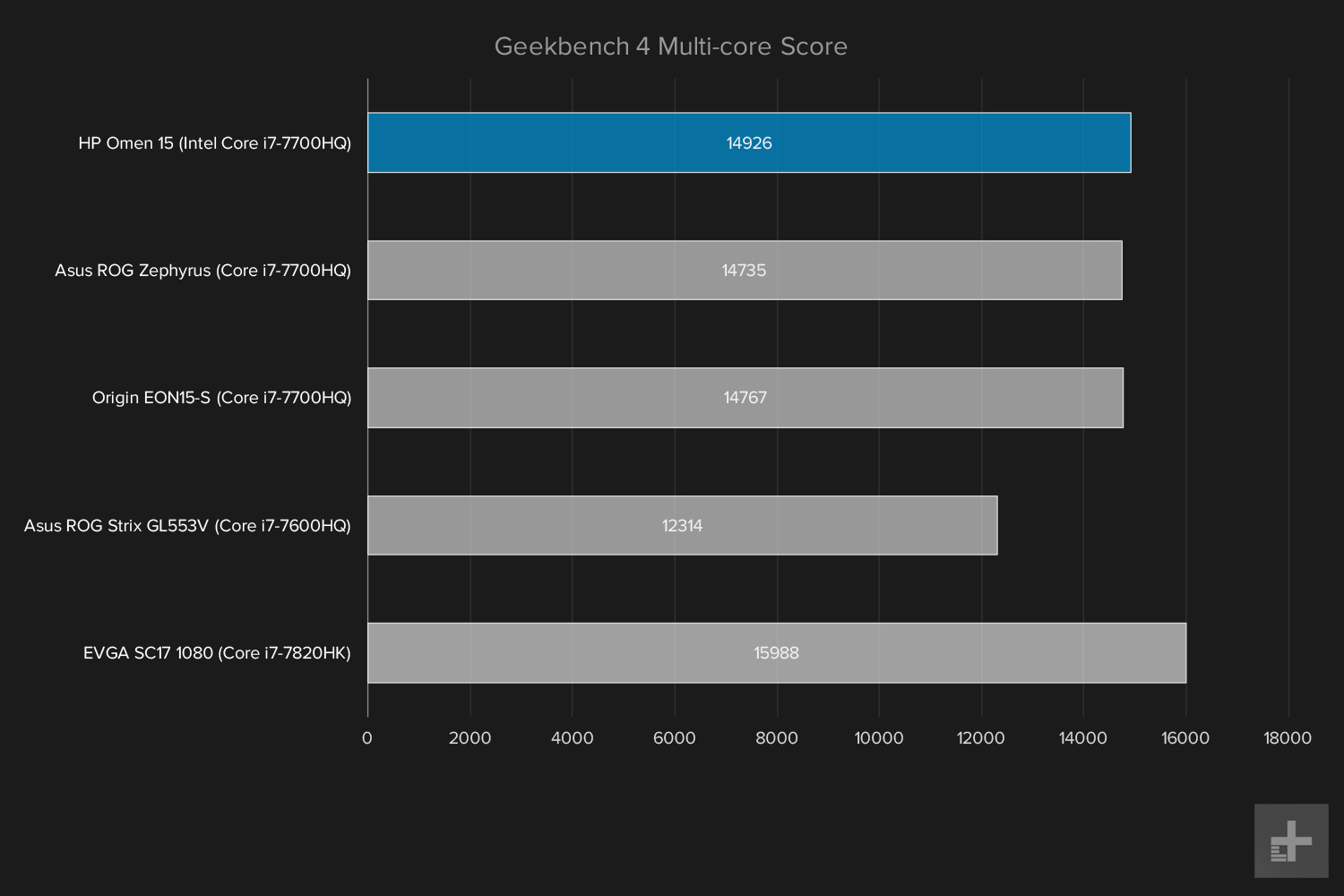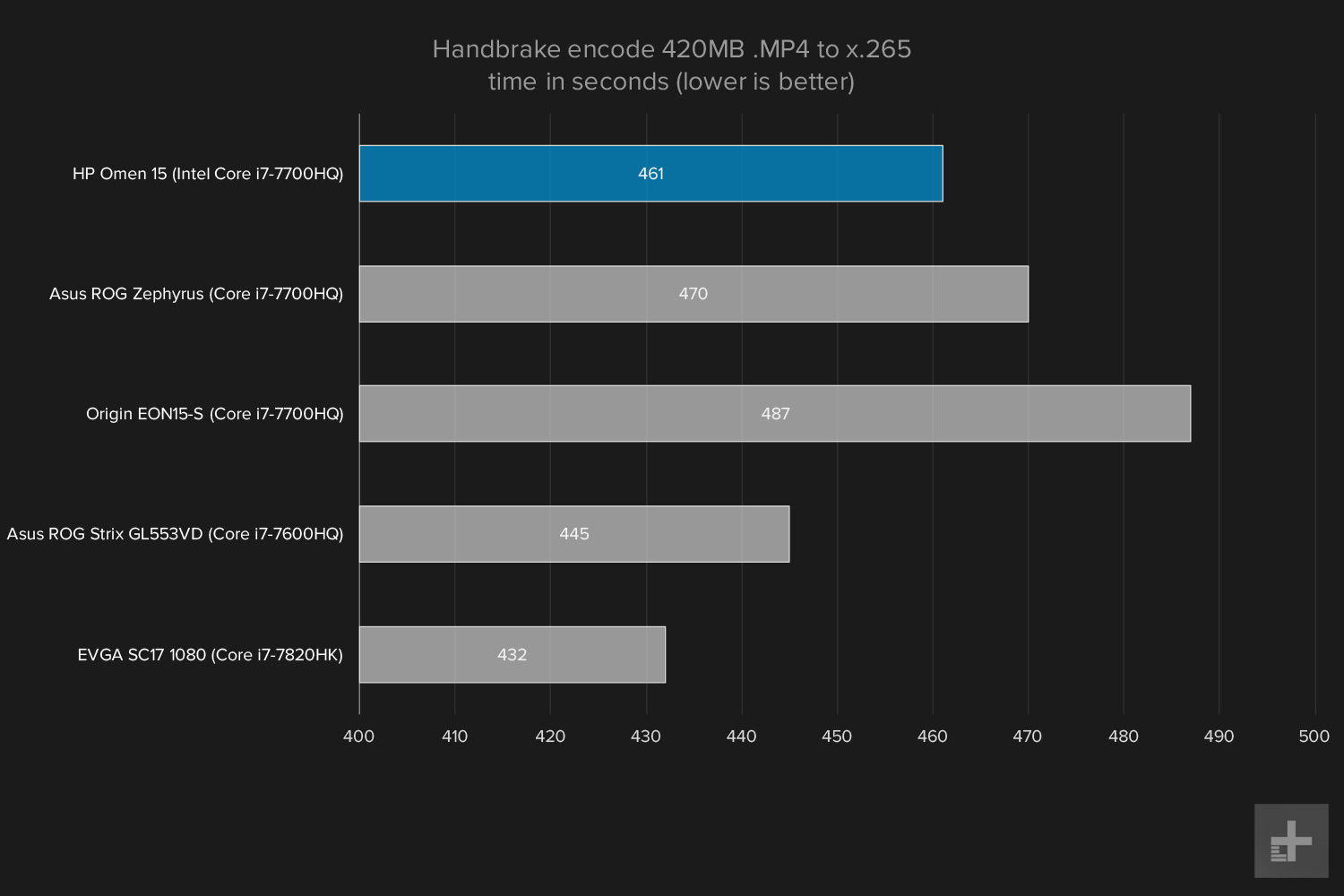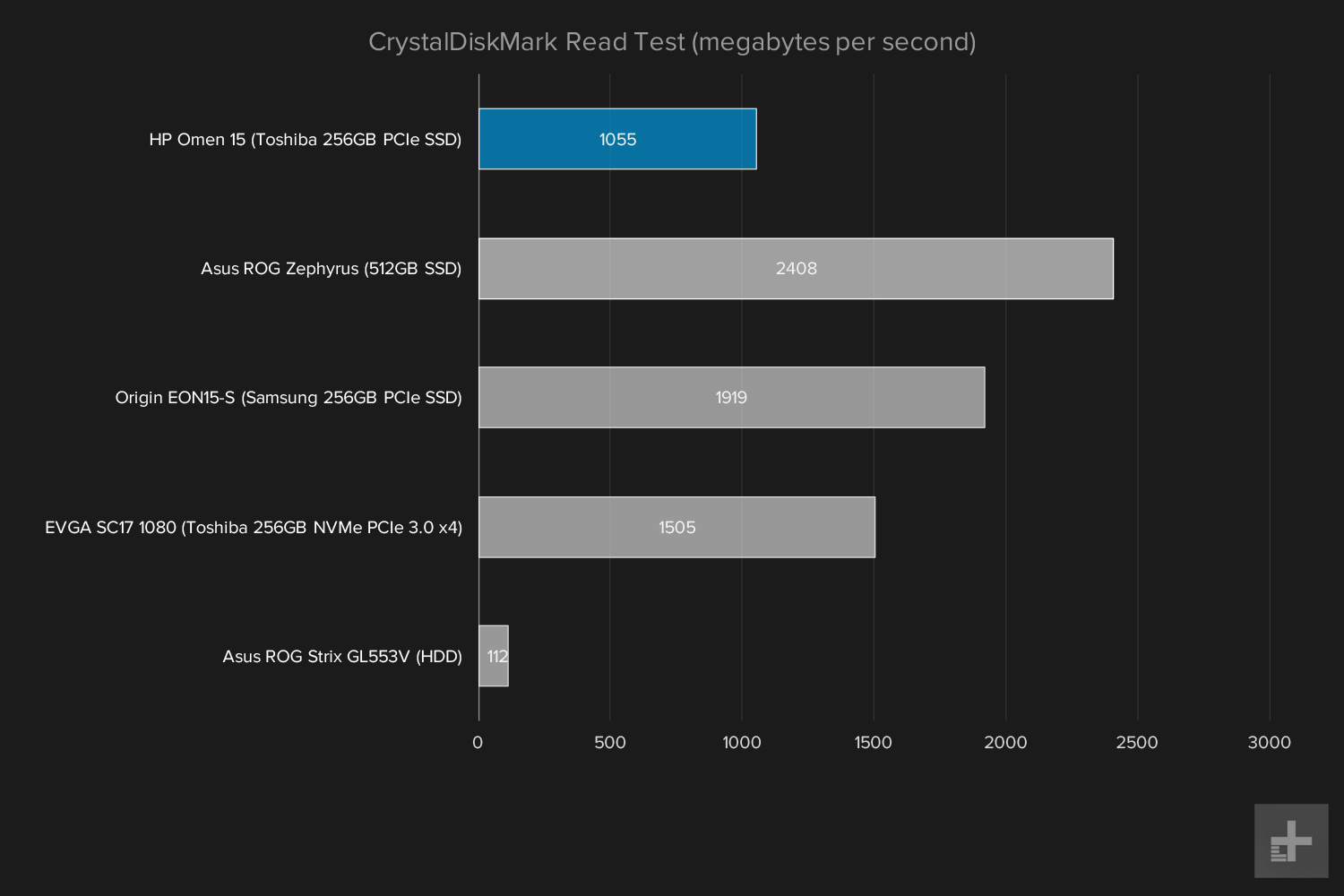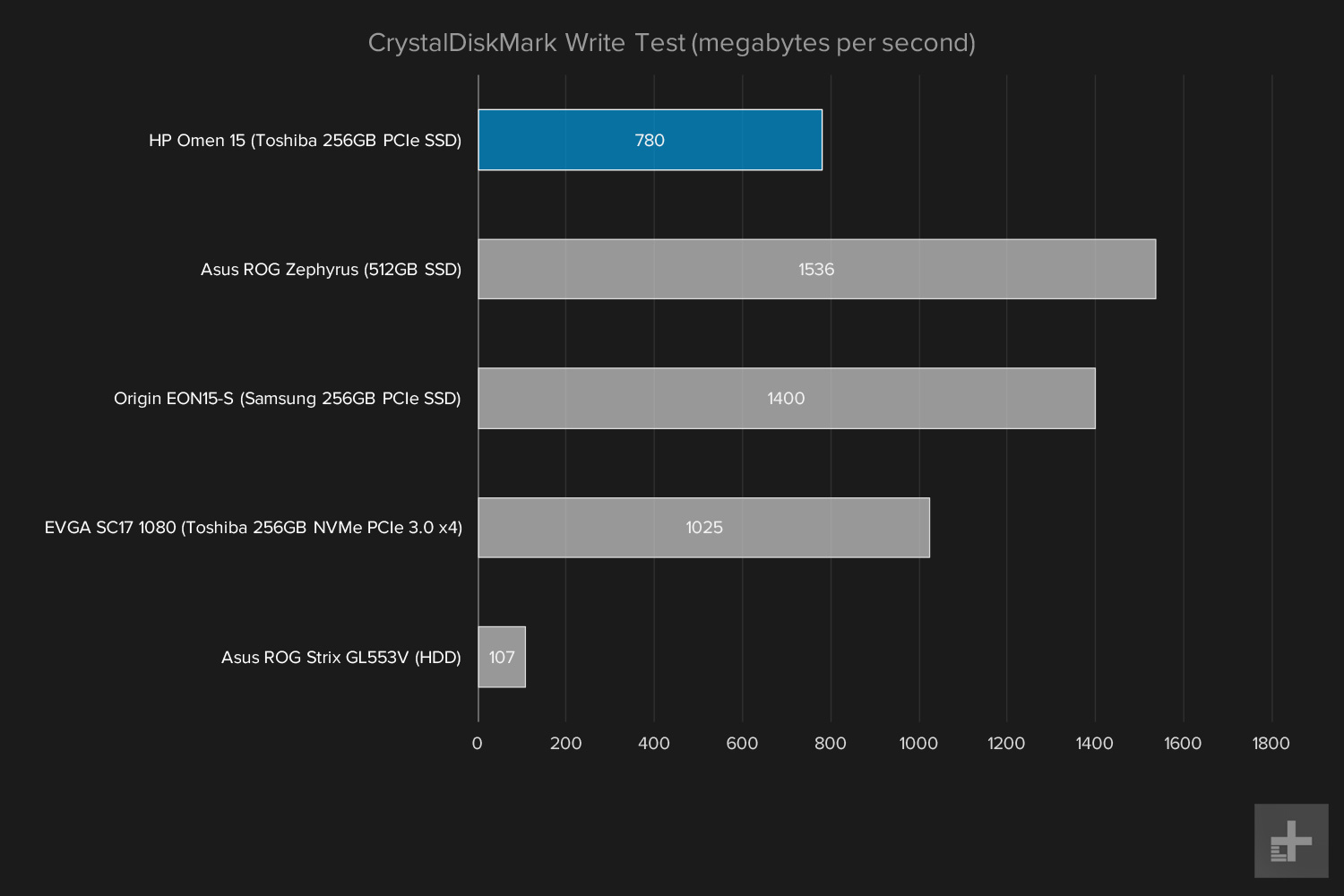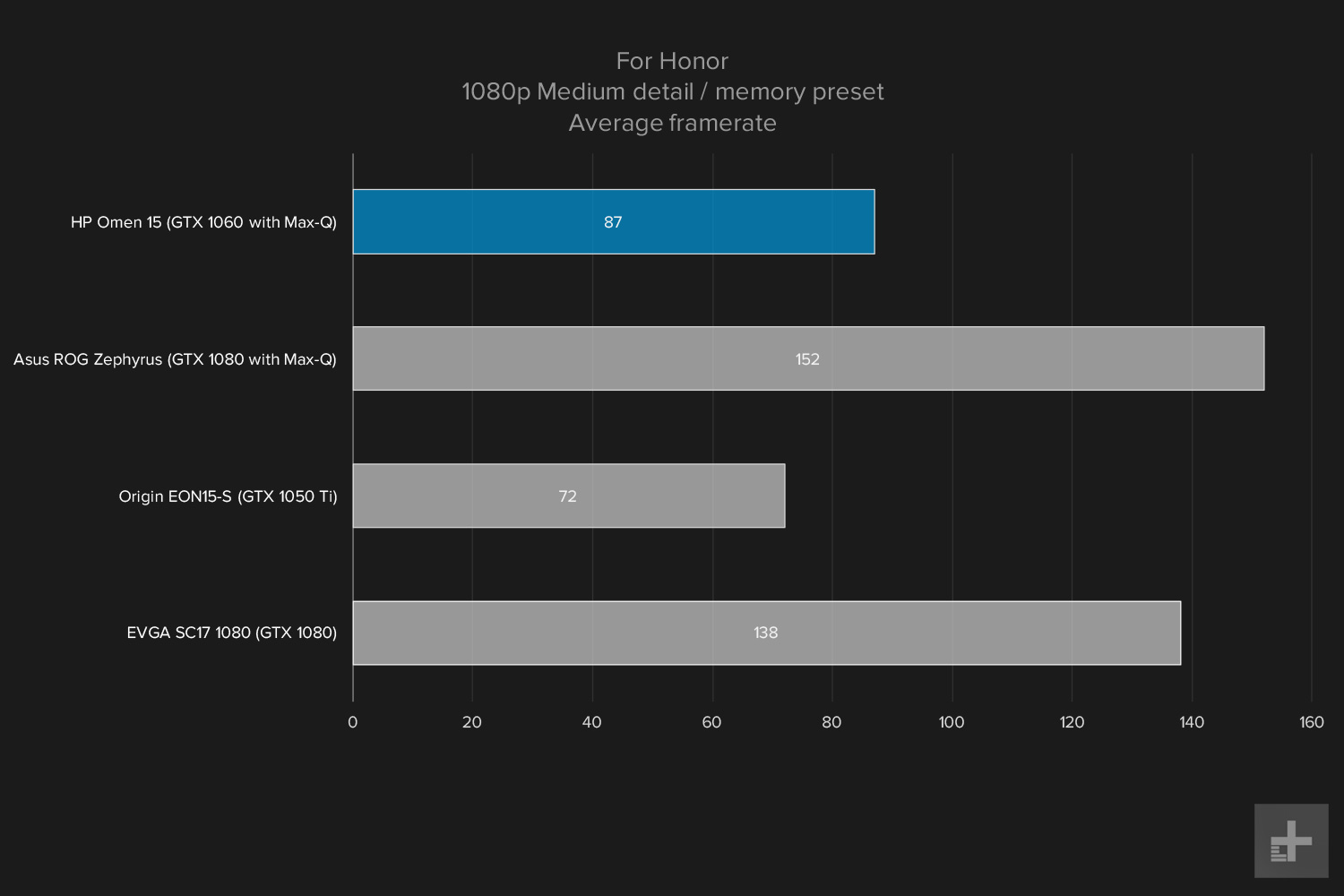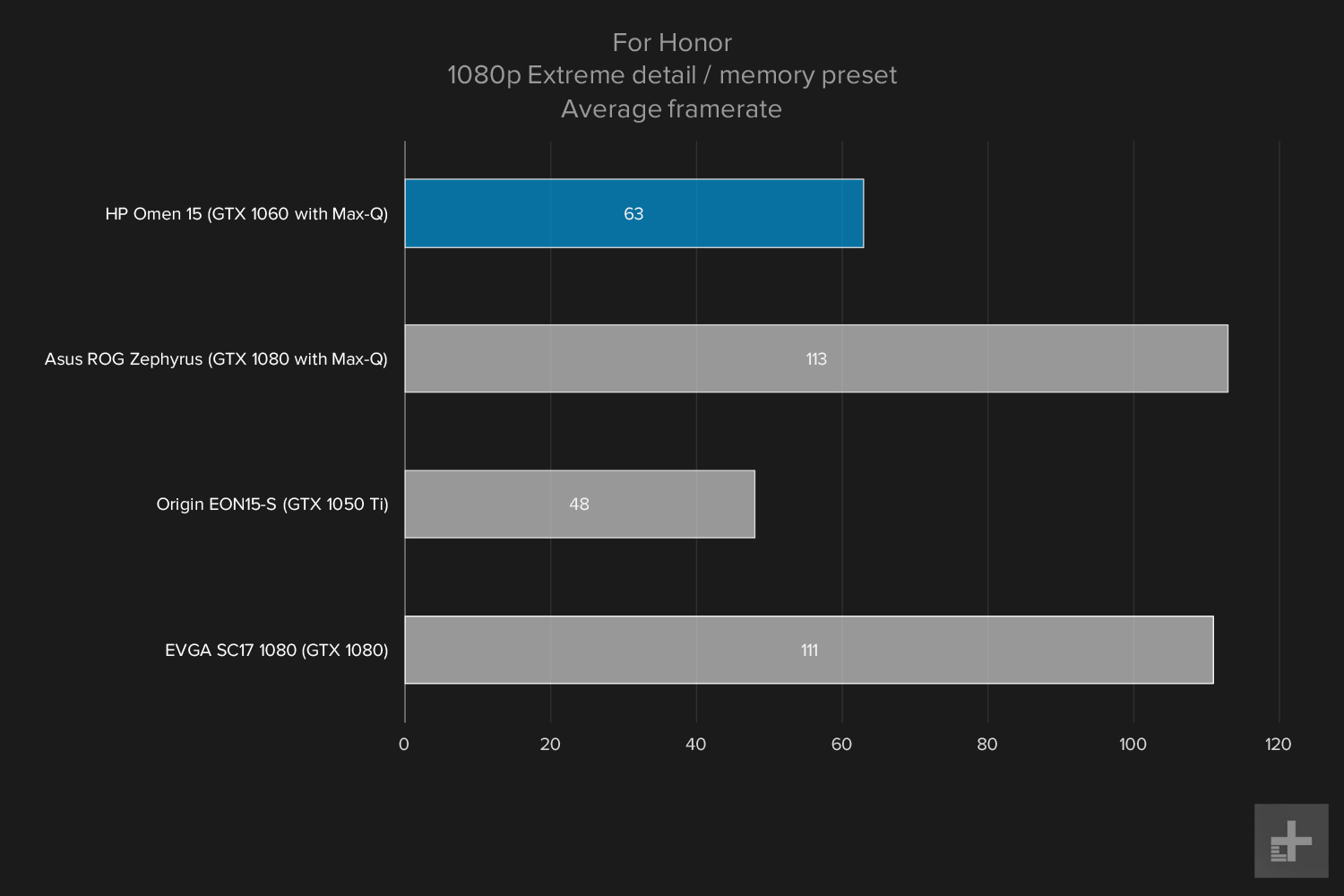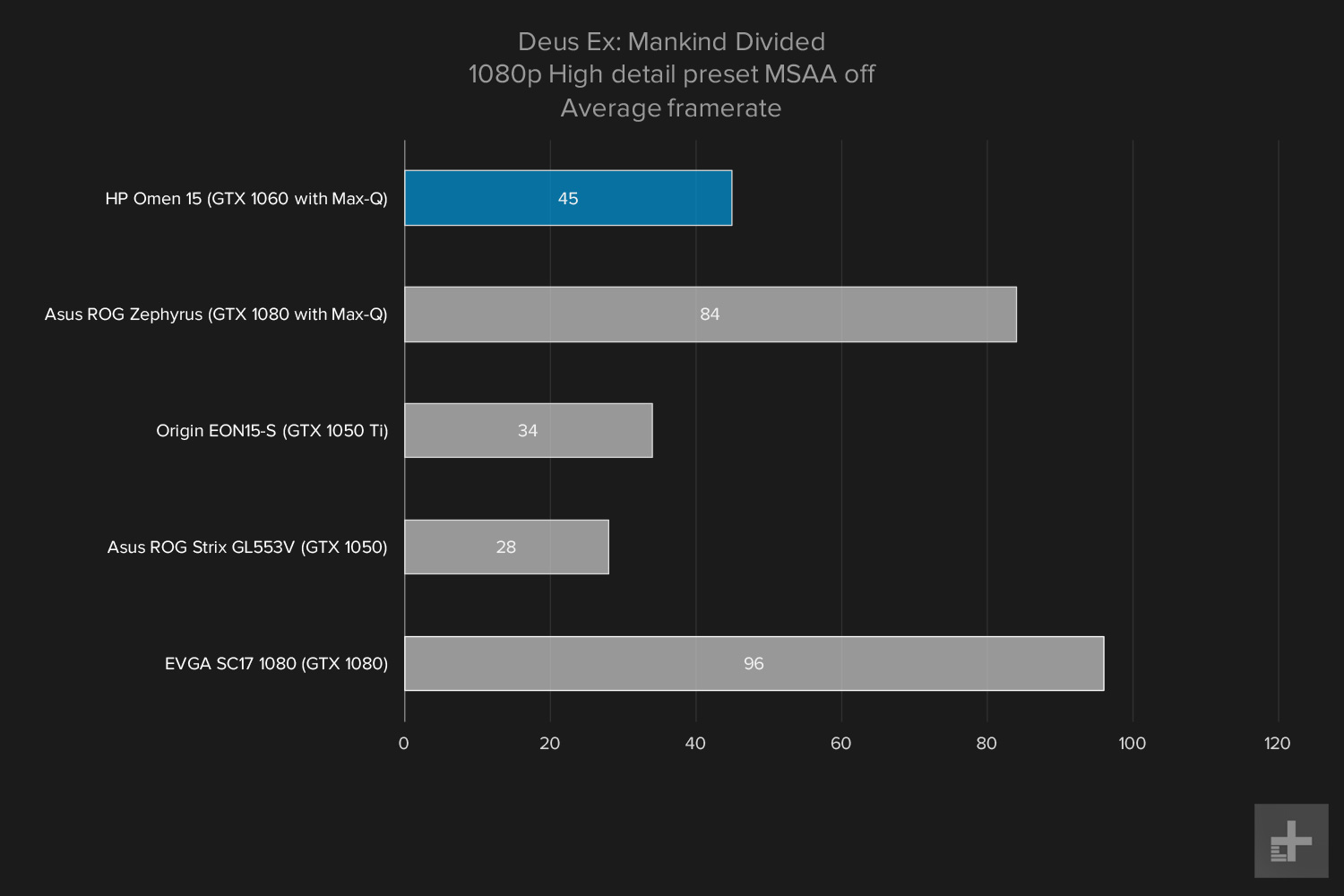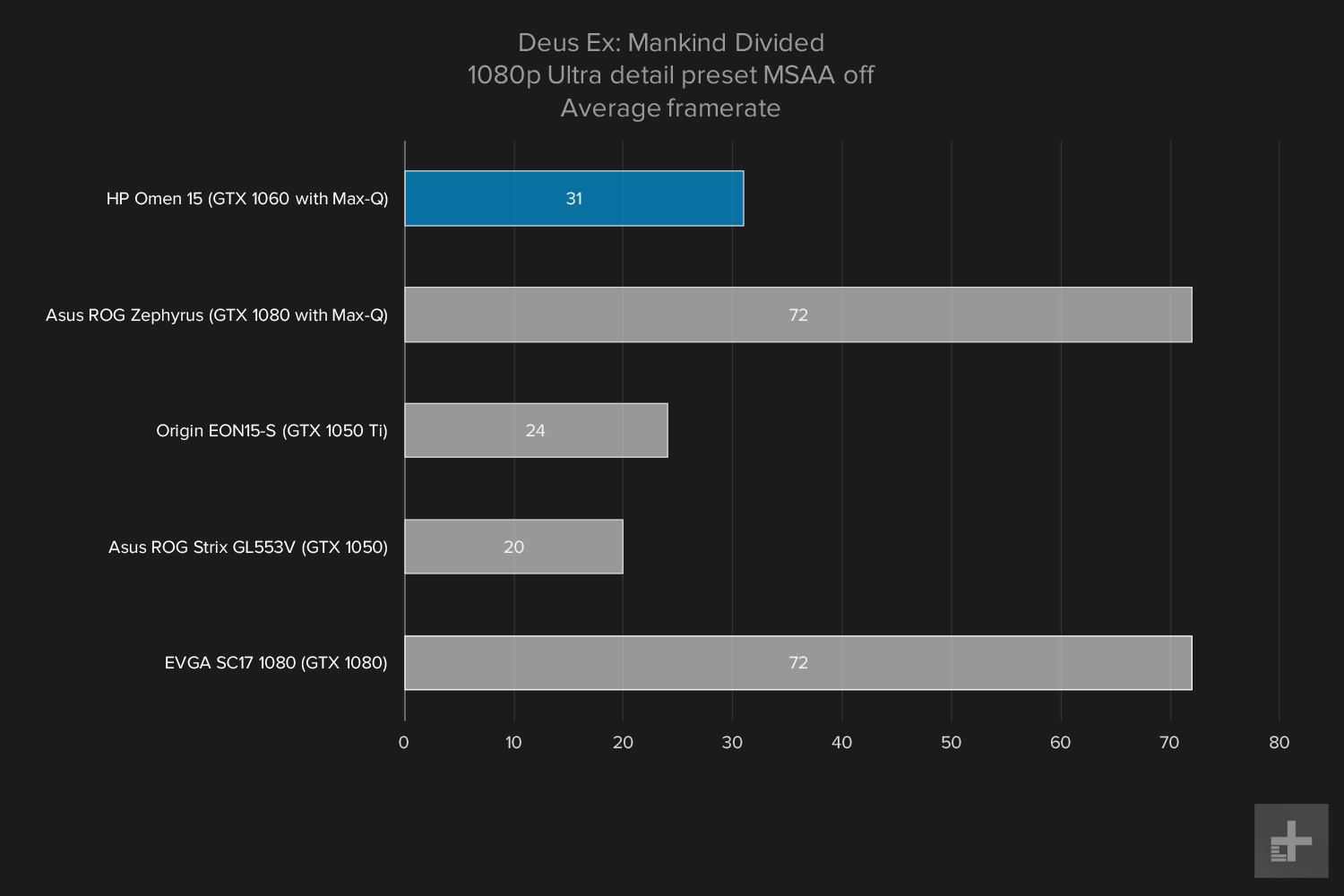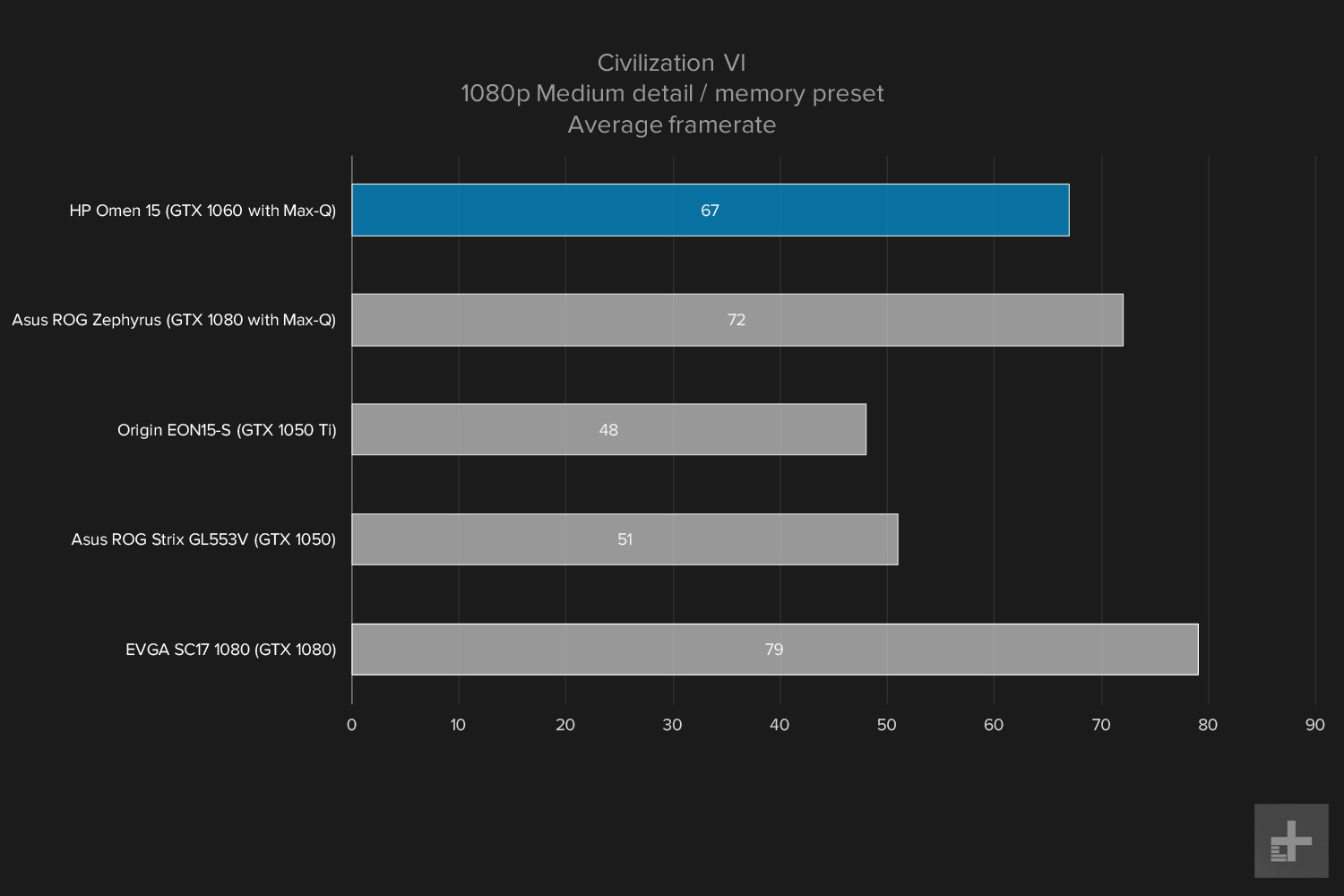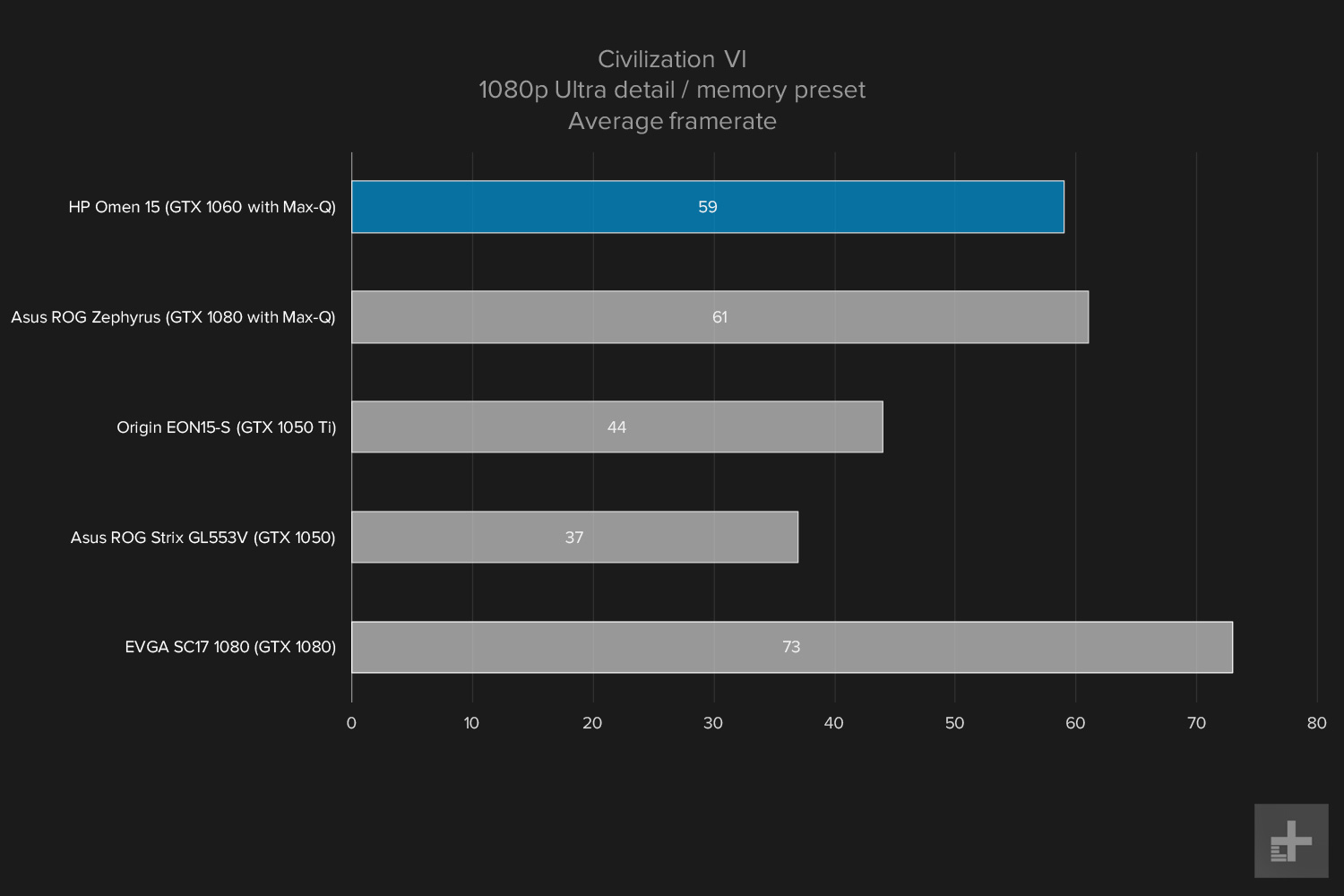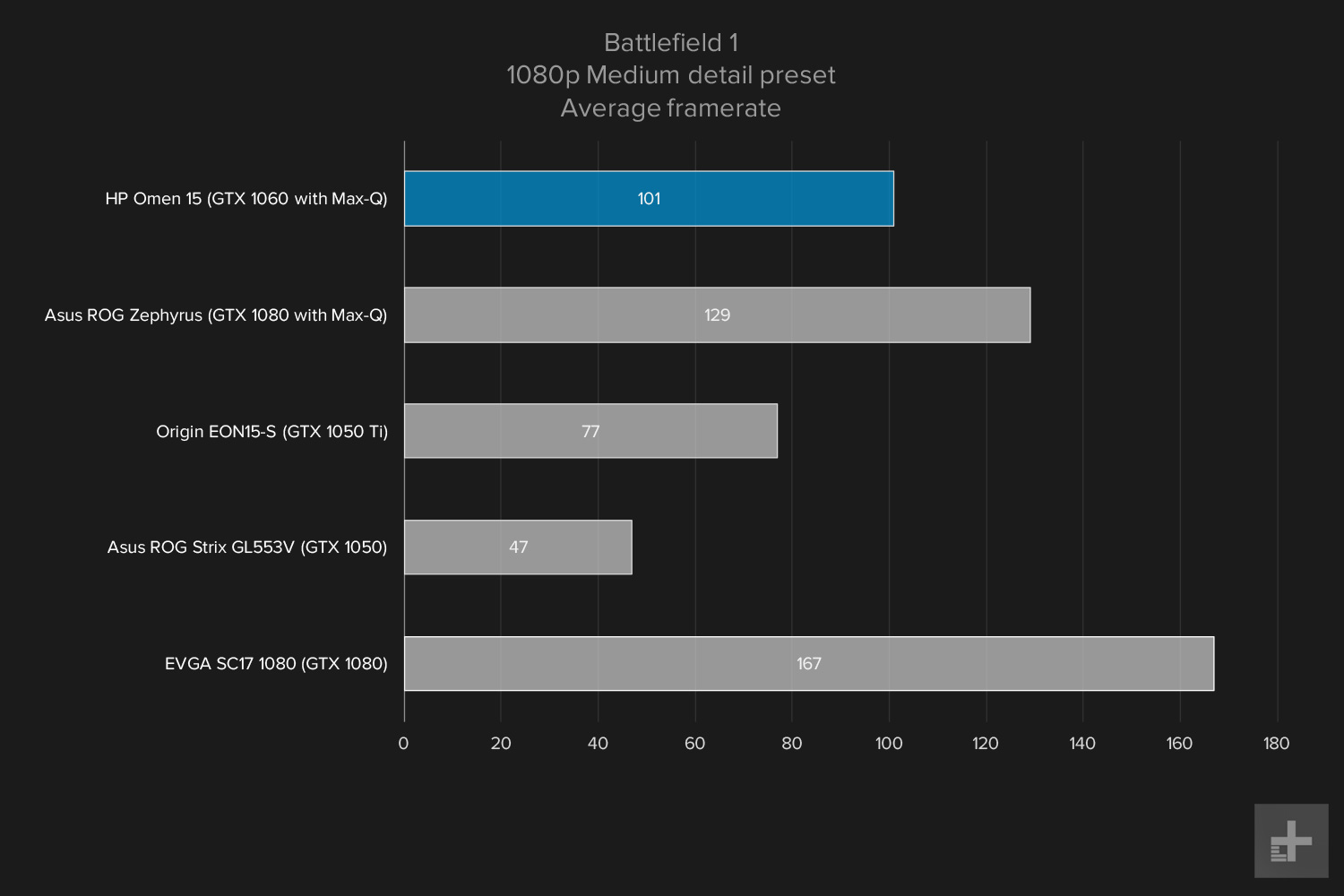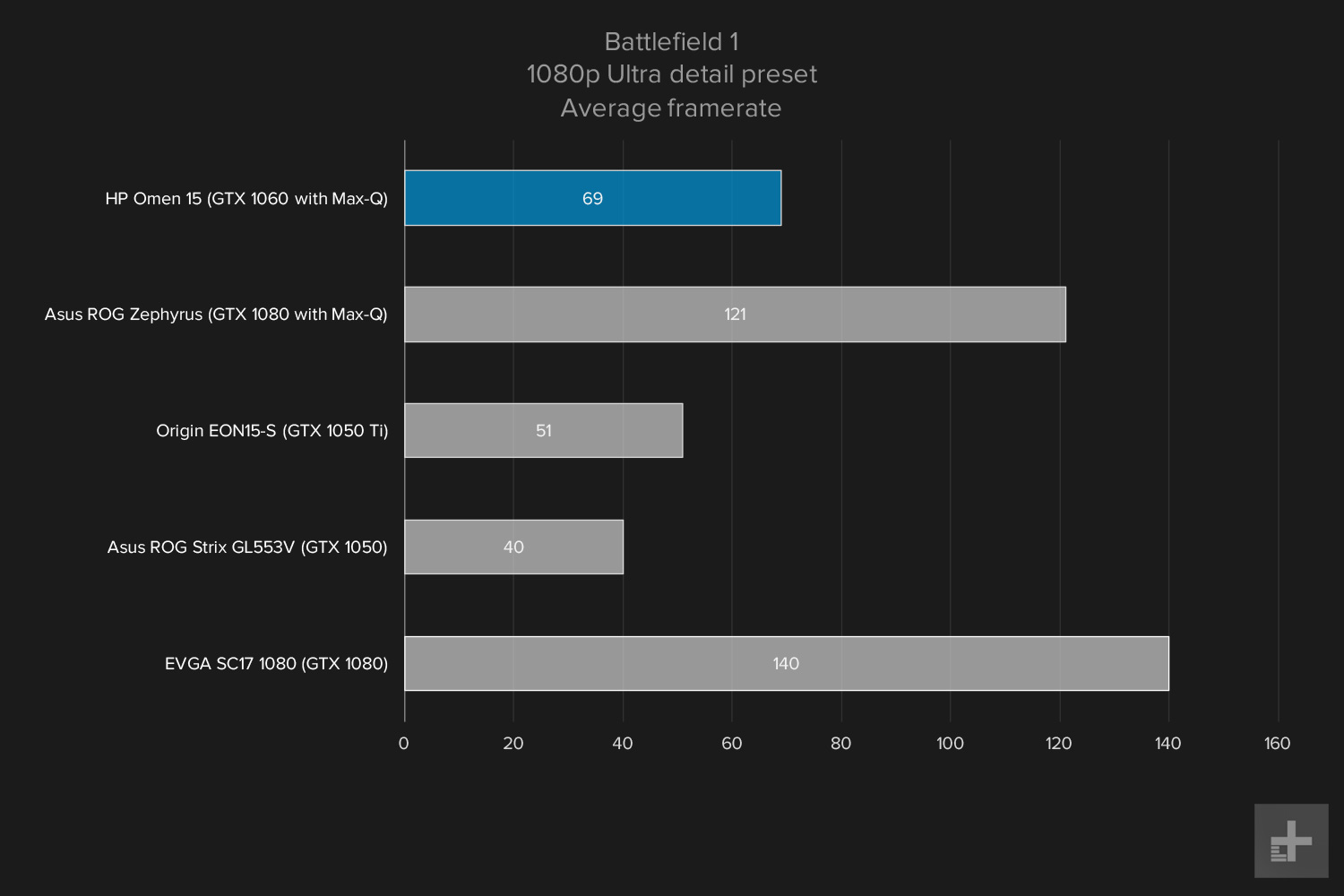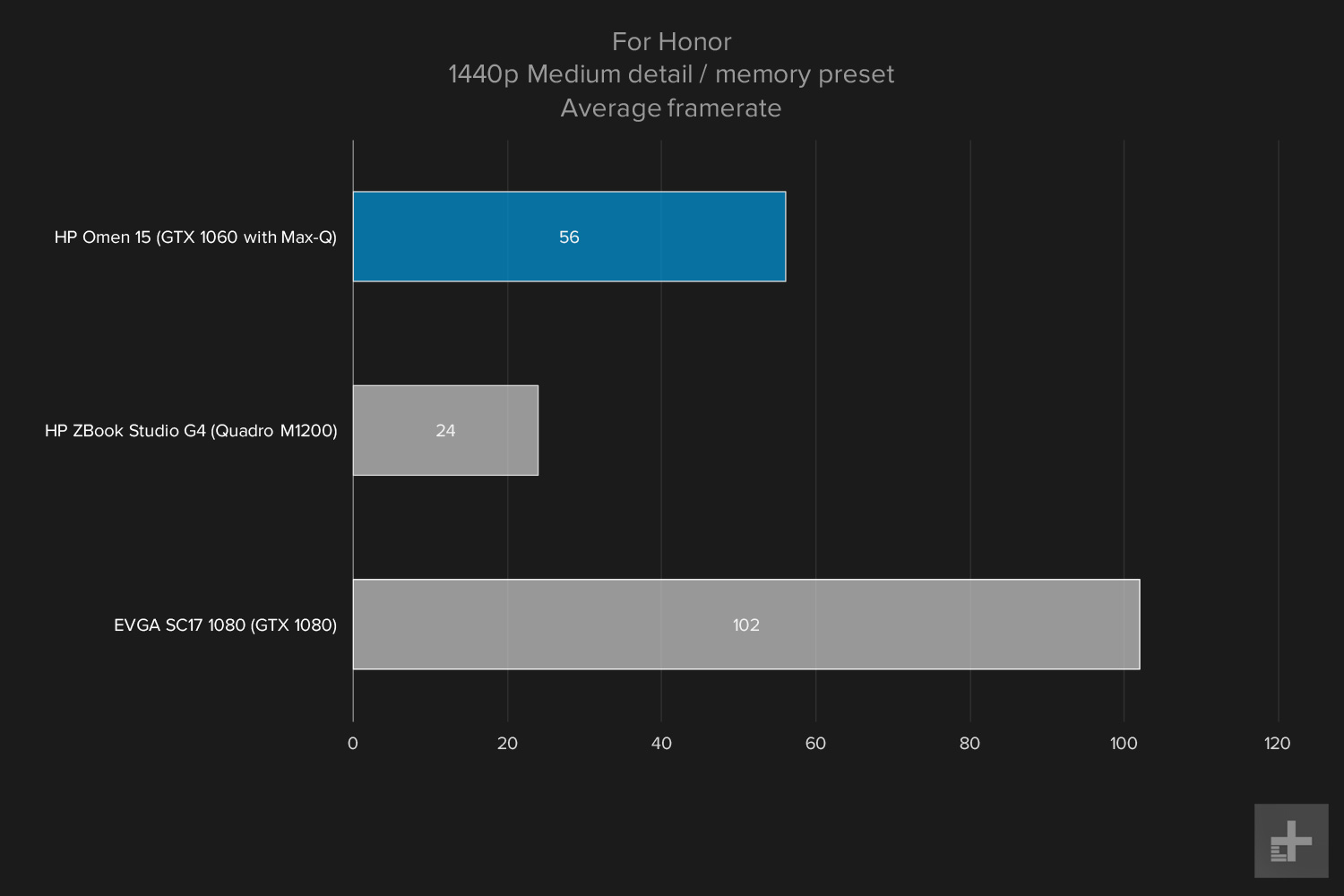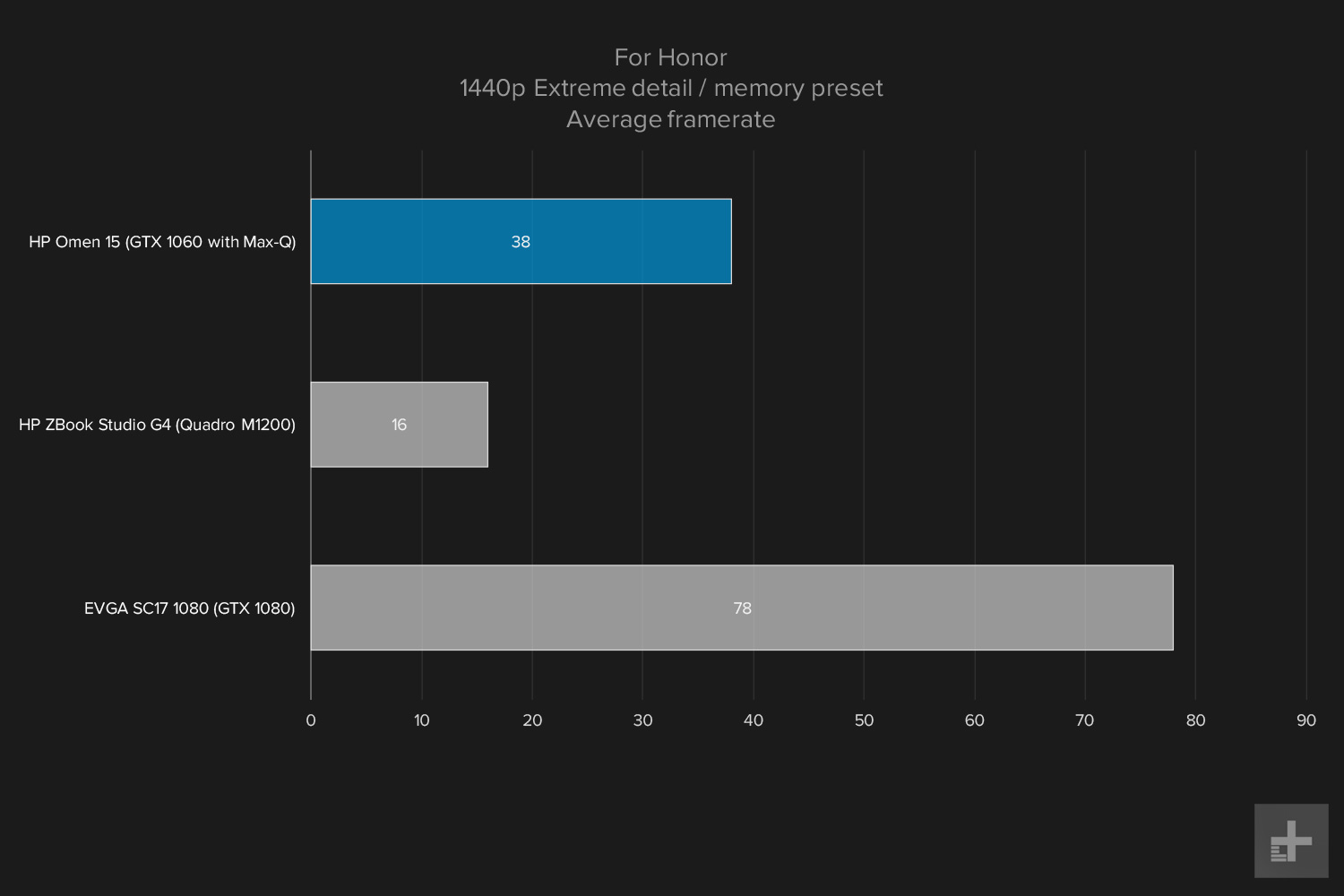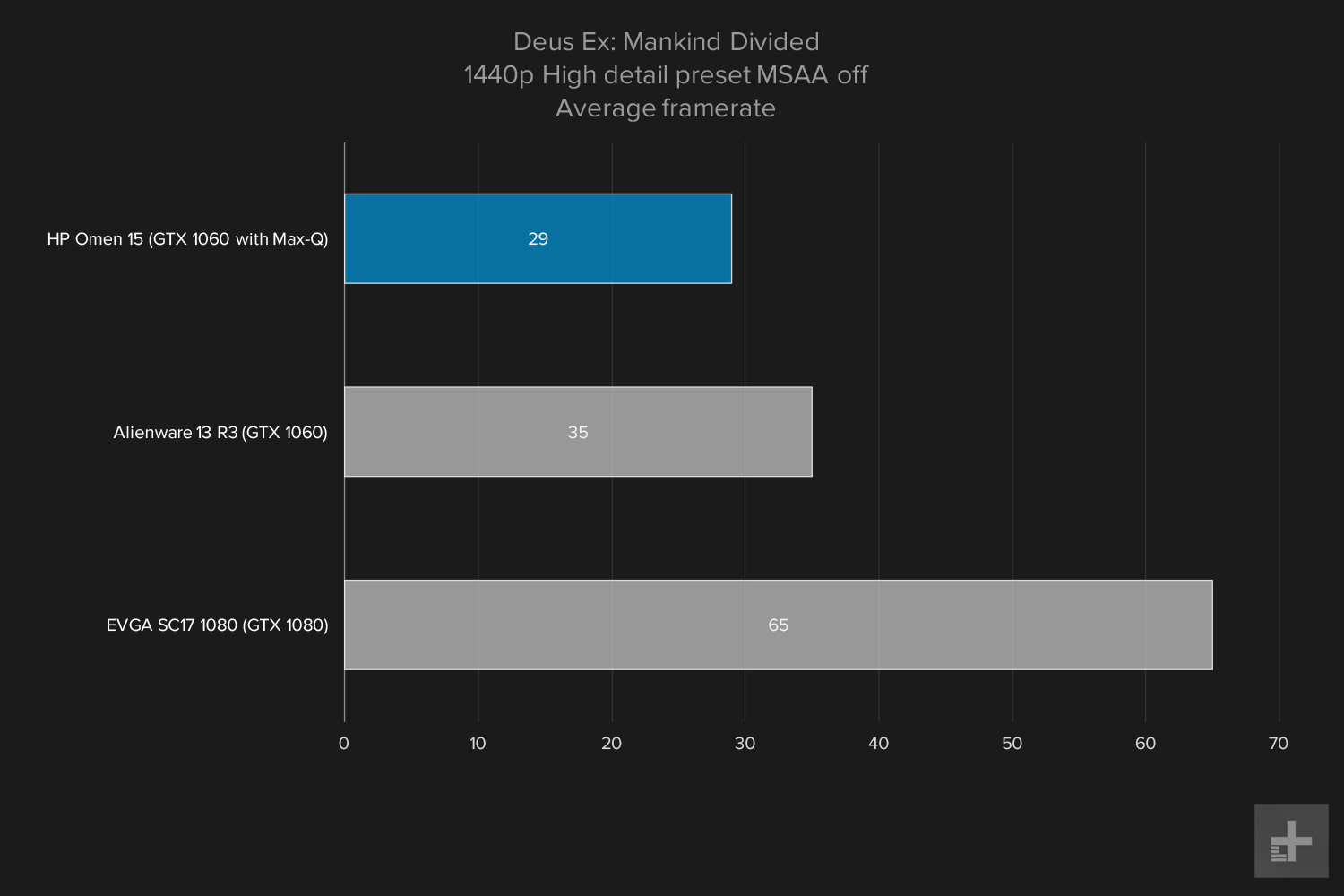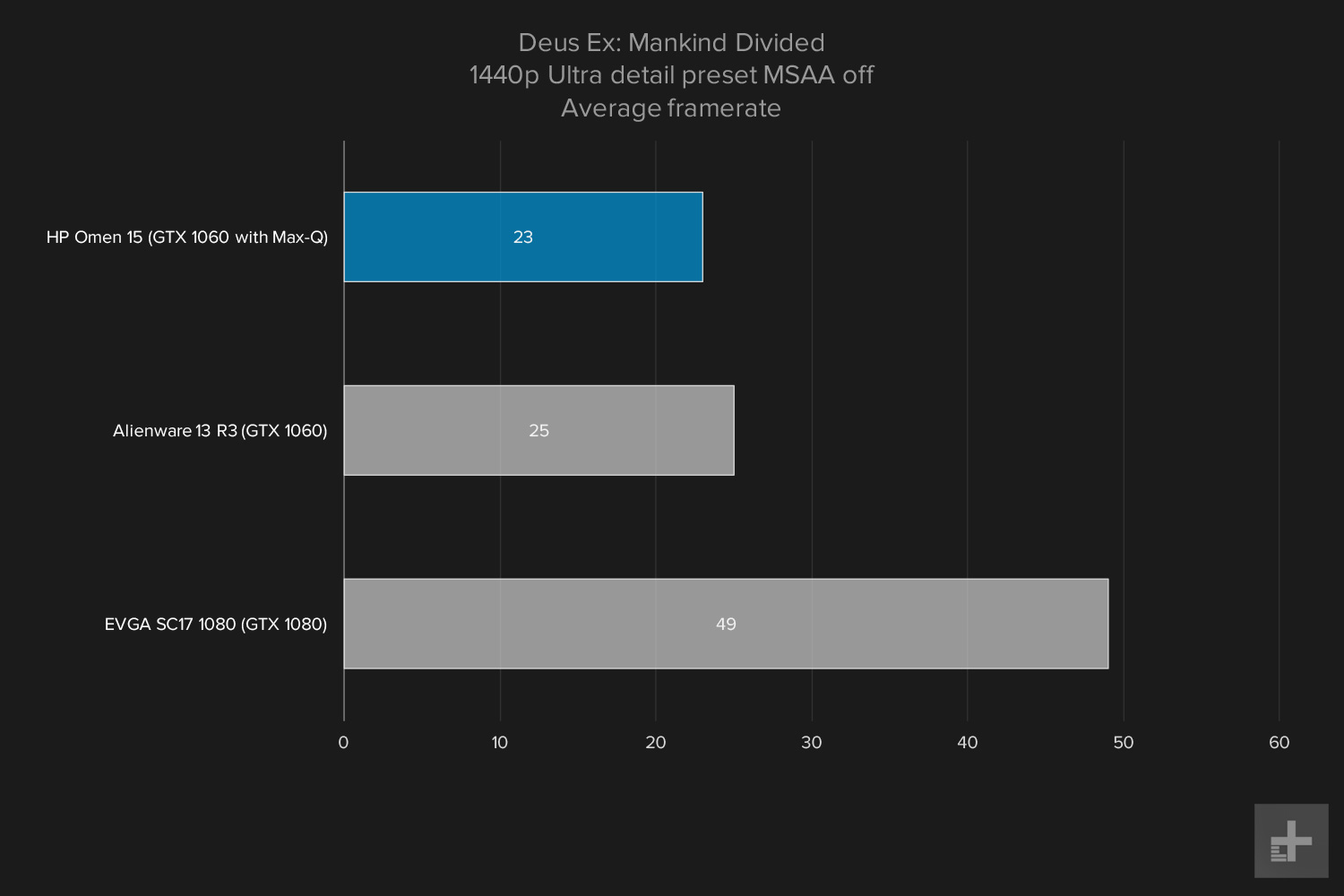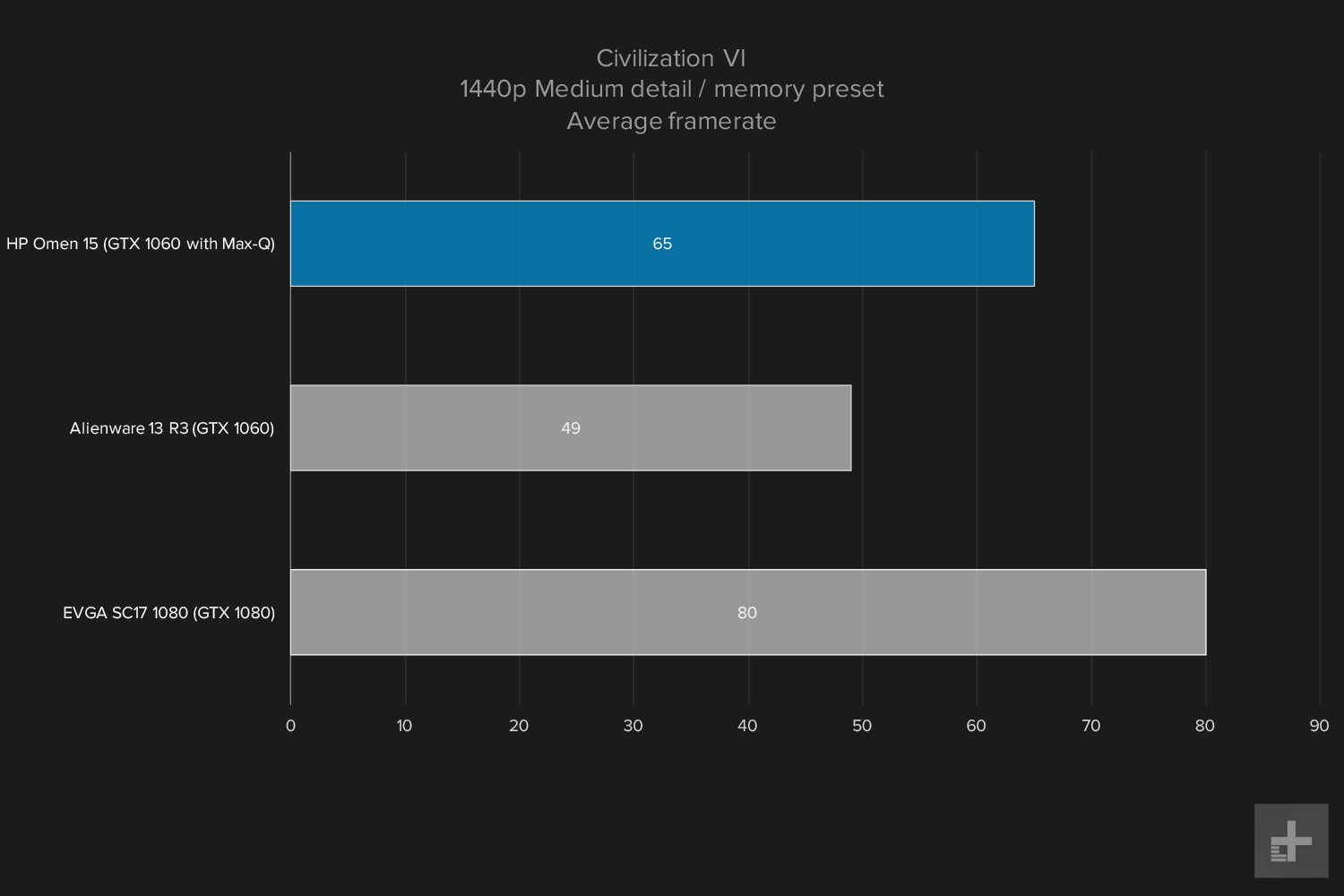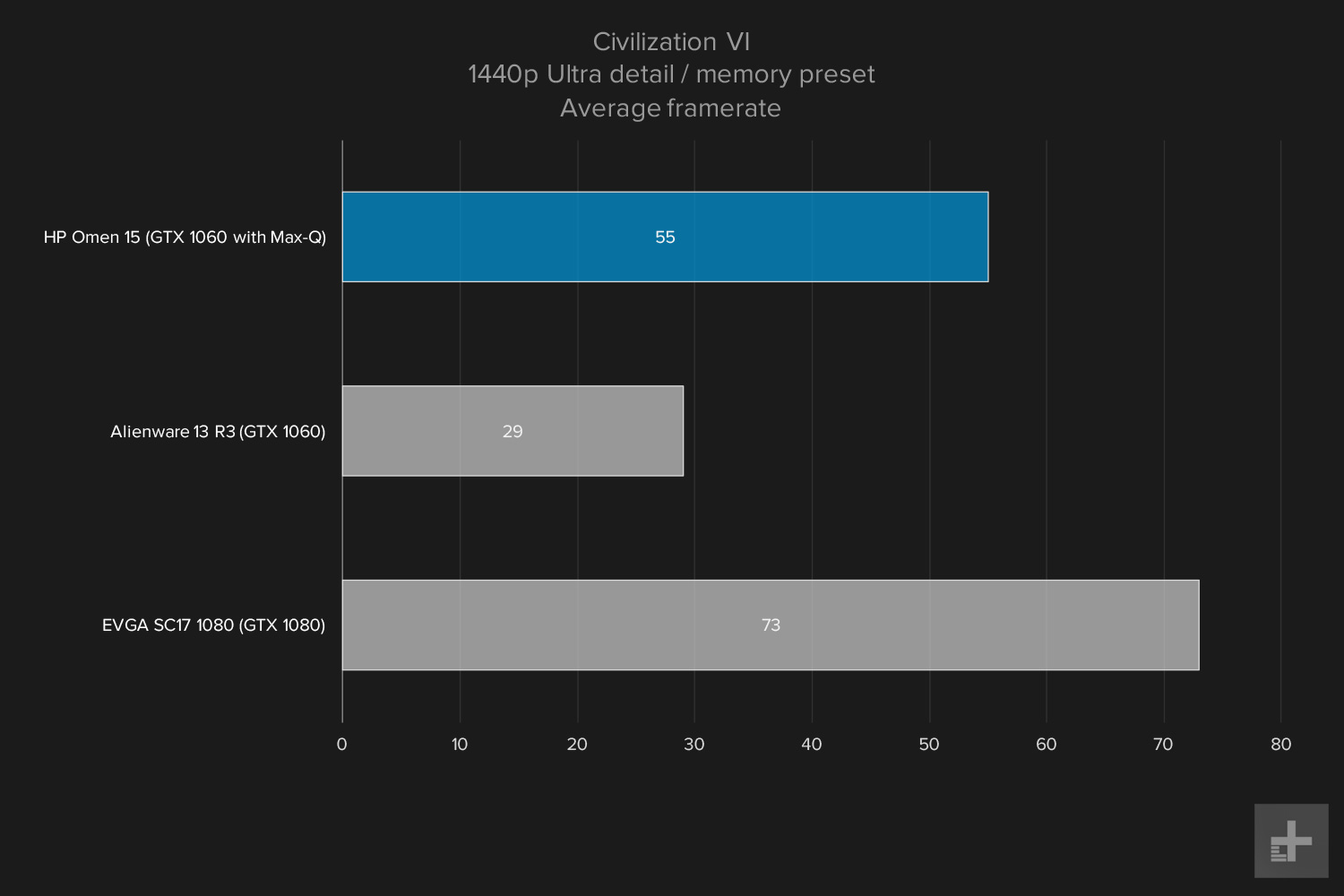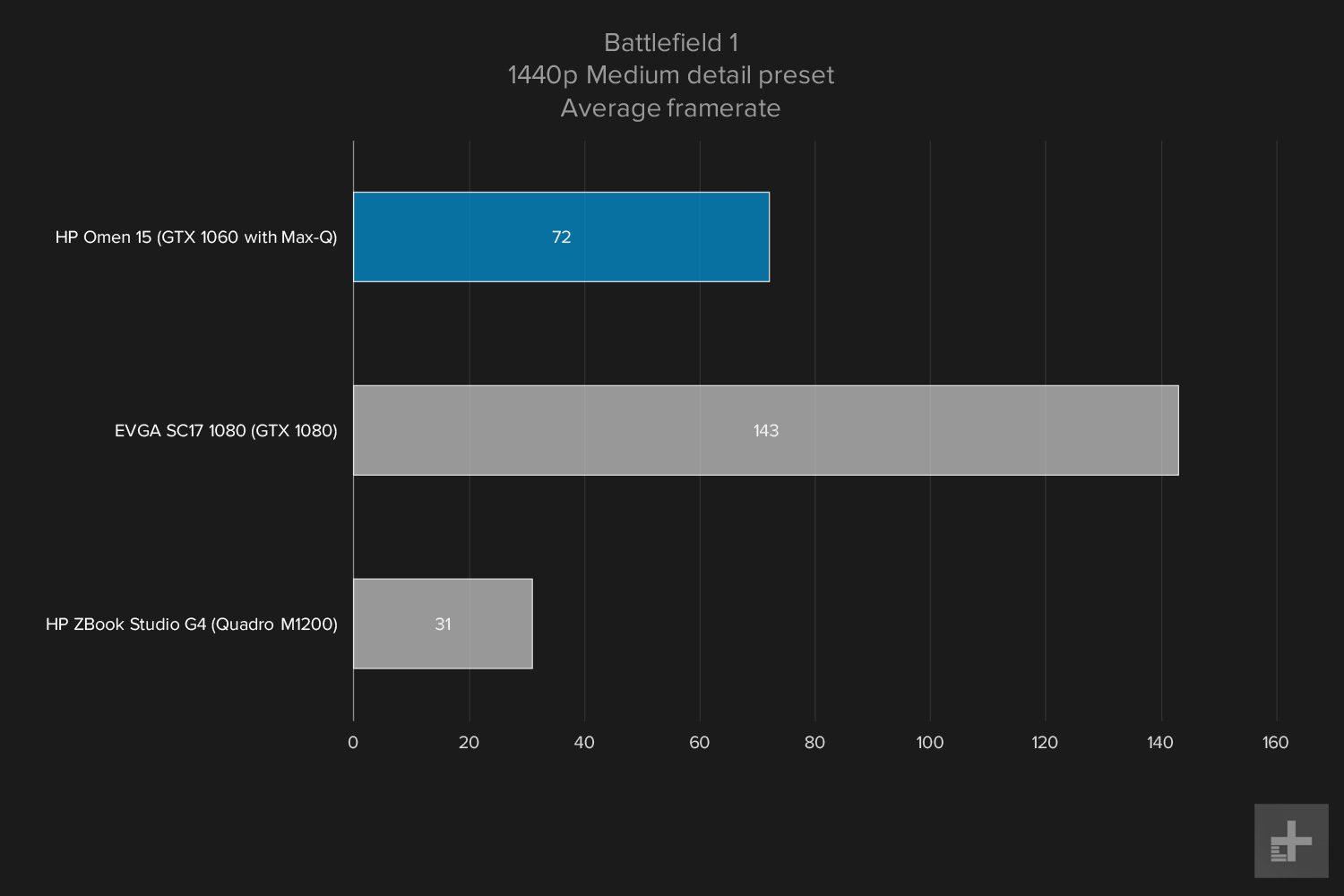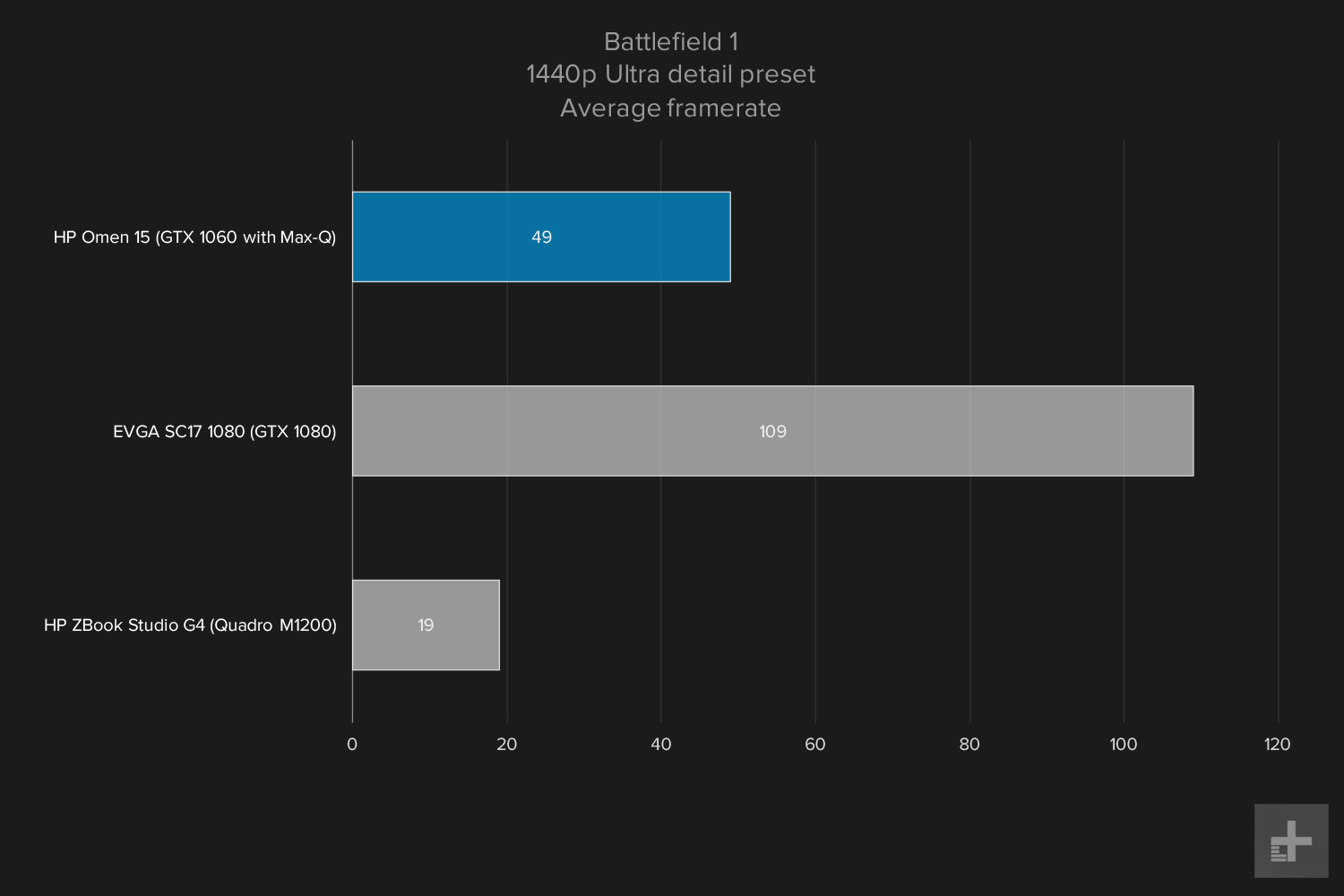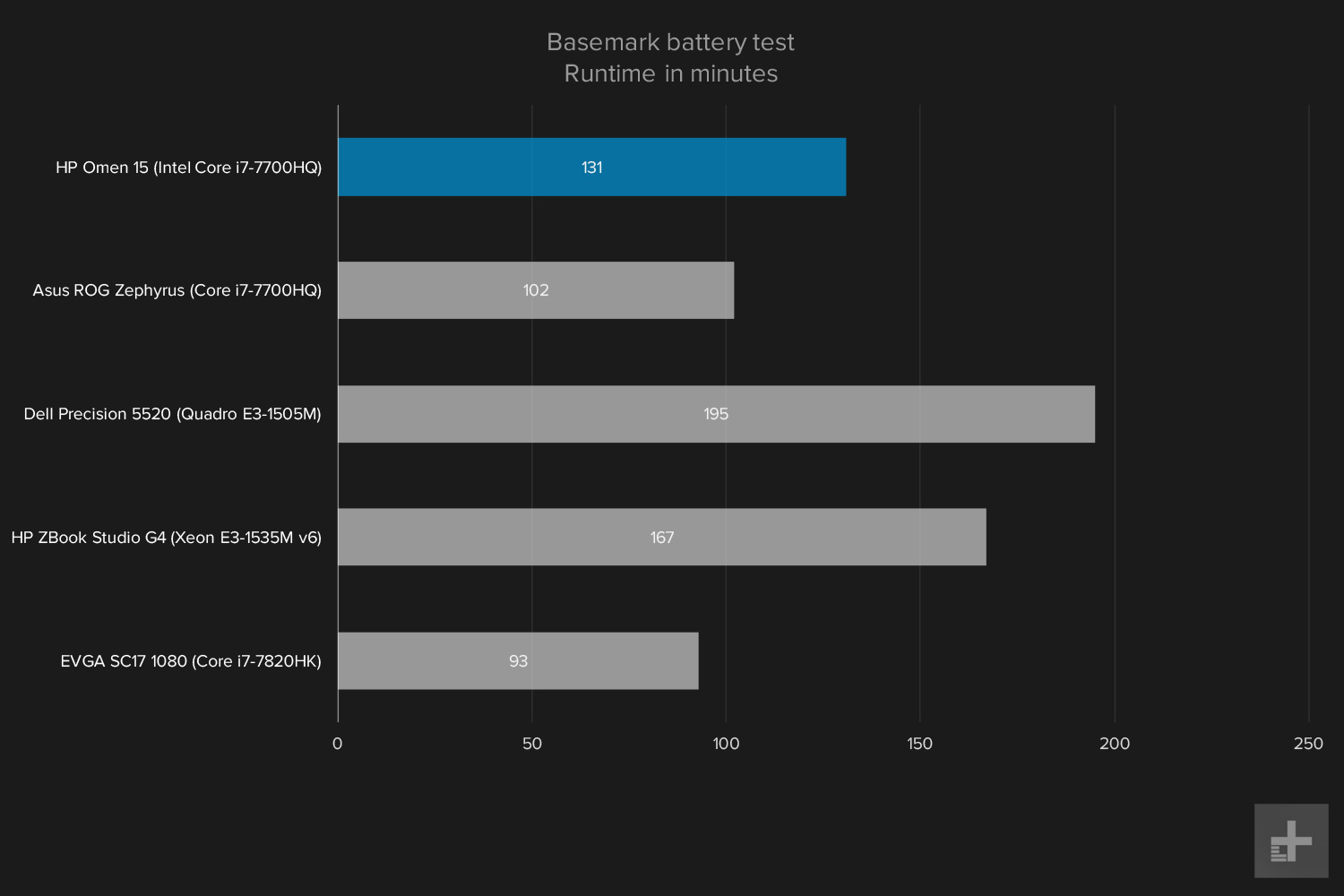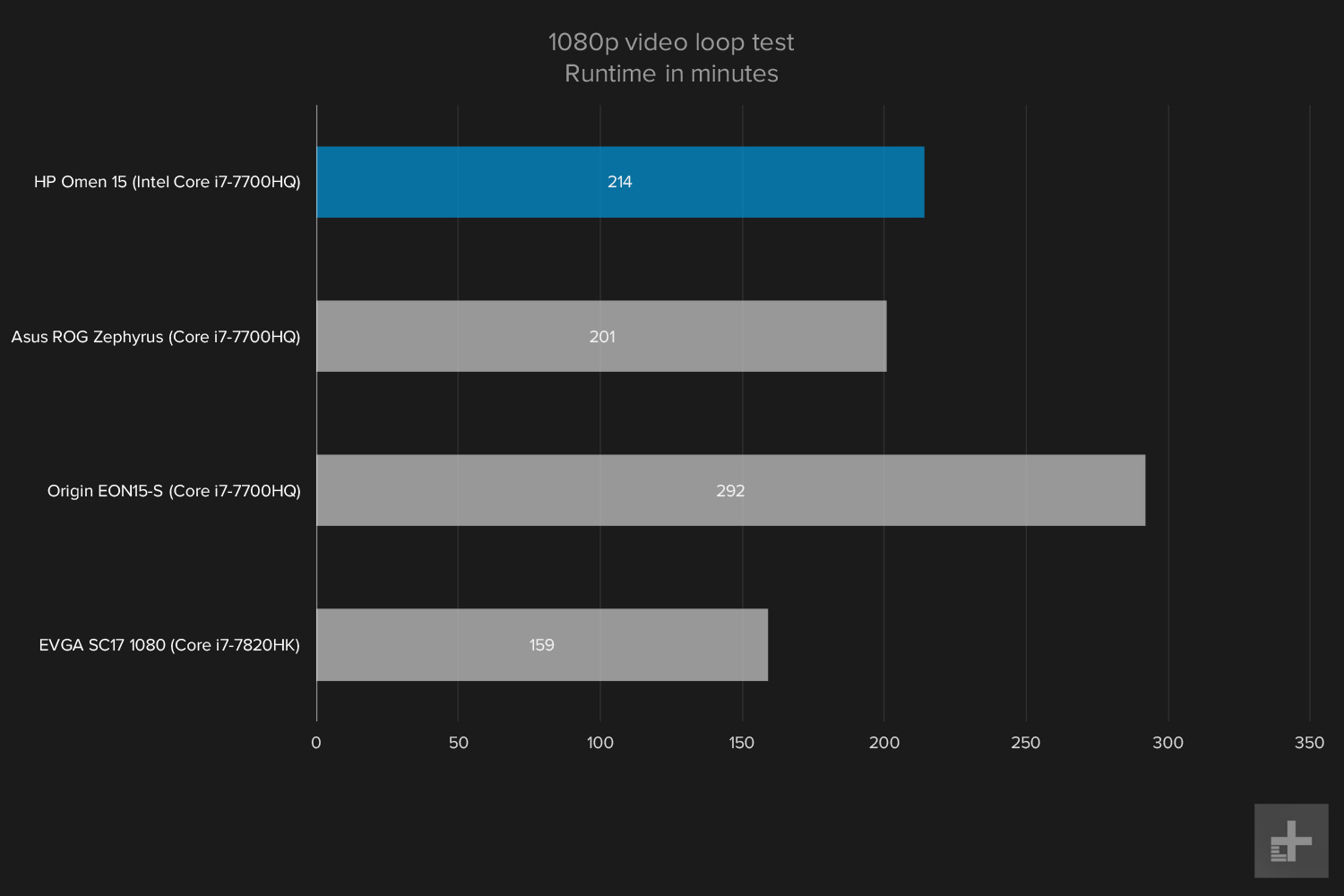- Solid build quality
- Attractive design that avoids being garish
- Competitive gaming performance
- Quality 4K UHD display
- Fans get very loud
- Optional 4K panel can overwhelm GPU in games
HP has been a player in the gaming notebook space for a few years now, with its Omen line hitting the market in 2014, returning the company to the space after something of a hiatus. The 2016 Omen 15 was the company’s midrange entry, and it suffered a bit from being based on the HP Pavilion chassis. However, HP has returned to a more maverick design for 2017. In our HP Omen 15 review, we look at its refreshed aesthetic and revved up components to see if HP’s latest gaming notebook stands up to the competition.
We were sent the most lavish model to review, configured with an Intel Core i7-7700HQ quad-core processor, a
Does the HP Omen 15 live up to its promise? Read on to find out.
Finally, an Omen laptop deserving of the name
The Omen 15 benefits tremendously from the company’s 2017 refresh of the Omen line. It’s no longer just a revamped HP Pavilion, but rather incorporates some distinctive flair with the same design cues as the rest of the Omen line — down to the x-shaped Dragon Red flair on the lid, and the iconic Omen logo. HP has worked hard to create consistent designs across its various product lines, and it’s obvious that the Omen 15 is a bona fide member of HP’s new gaming lineup.
Entirely red and black, it’s aggressive enough to appeal to gamers, while not quite tipping over into being garish. The venting takes on the same jet engine exhaust motif in the rear as is common with this kind of machine, and the chassis is all angles. This is a futuristic design that won’t be mistaken for a productivity notebook, but it’s also not going to embarrass if it’s taken to a coffee shop to get some work done.
Our real-life gaming tests are a testament to Max-Q, demonstrating solid midrange performance.
Most of the HP’s exterior is plastic, as expected in this price range, and it’s plenty solid without any creaking or buckling. The hinge is smooth and sturdy, and the aluminum keyboard deck is free of noticeable flexing — although that bit of metal does readily pick up smudges. The display lid cover isn’t stiff enough in its center portion, however, and it readily flexes, making it the one surface that doesn’t quite evoke confidence in the overall build.
The Omen 15’s recent refresh has improved thermal management, which includes larger fans and heat pipes to accommodate the new GTX 1060 with Max-Q. The jet engine exhausts aren’t just for show, either, as the hot air produced during heavy gaming sessions is now vented out the back rather than the side, as with the previous design. The resulting 21 percent increase in maximum airflow promises less CPU and GPU throttling, and is a significant upgrade over the previous design.
In an all too rare move, HP makes it easy to open the chassis and upgrade components. That means the
A passel of ports with network optimization tossed in
When you design a notebook today that’s an inch thick, there’s no excuse for leaving users unable to connect to their favorite peripherals. Thankfully, HP takes advantage of the space.
Along the left-hand side you’ll find a mini-DisplayPort, a full-size HDMI port, a gigabit Ethernet port, a USB Type-A port, a USB Type-C port with Thunderbolt 3 support, a headphone jack, and a microphone jack. Whew. On the right-hand side, you’ll find two more USB Type-A ports, an SD card reader, and a power jack.
In terms of networking, the Omen 15 is equipped with Bluetooth 4.2 and Wi-Fi with 2×2 MU-MIMO support. Because this is a gaming system, HP’s Omen Command Center software adds in the ability to optimize networking to ensure good performance for multiplayer gaming. Users can either tune the Wi-Fi to prioritize gaming packets, or better yet can connect an
A great keyboard for work or play
HP’s red-shifted design aesthetic carries forward to the keyboard, with Dragon Red backlighting and keys that are red on black when the backlighting it turned off. The WASD keys stand out with white on red lettering. The Omen 15 offers three backlight settings — off, all keys backlight, and just the WASD keys backlit.
HP makes it easy to open the chassis and upgrade components, including
The keyboard supports 26-key rollover and anti-ghosting, ensuring that every keystroke is registered, and letting gamers execute multiple commands simultaneously. In addition, HP has made the arrow keys full size, and set them slightly apart from the rest of the keys. Hardcore gamers might be bummed that the keys aren’t mechanical, though they nevertheless provide a solid experience with more than sufficient travel and a crisp response.
The touchpad is surprisingly good, albeit a touch small, with a comfortably slick coating that still allows for precise control. The buttons take some getting used to for anyone who’s used to one-piece touchpads, but they’re sufficiently sized and responsive enough to be effective. The touchpad doesn’t conform to Microsoft’s Precision Touchpad protocol, but the Synaptics drivers offer support for basic multi-touch commands like scrolling and pinch-to-zoom.
Finally, the Omen 15 can be configured with an infrared camera supporting Windows 10 Hello password-less login. Our review unit was equipped with that option, and we found it easy to set up and use.
An unnecessary but nonetheless enjoyable high-res display
If you’re a gamer, then you probably expect — and maybe even prefer — your portable gaming rig to come equipped with a Full HD (1,920 x 1,080) display. HP will accommodate you just fine, but if you want a
As it turns out, our expectations were mostly met. The
These are excellent scores compared to notebook displays just a few years ago, and they’re absolutely great results for a gaming laptop, particularly one that’s sold under $2,000.
Toss in the fact that our review Omen 15 comes with a
Good speakers, but they can get too rowdy
The HP Omen 15 offers up Bang and Olufsen-tuned dual speakers located underneath the front of the chassis. They’re able to pump out some serious volume, which is a good thing for gaming given that they need to overcome some serious fan noise, and they’re well behaved up until about 90 percent volume. After that, audio can become distorted, so it’s better not to turn the volume all the way up.
For music and watching video, the audio is just acceptable. Bass is somewhat lacking, as usual, and music sounds a bit thin. Movie and TV audio is just fine, however, and there’s an app that allows the audio to be tuned somewhat based on the content. Overall, audio is better than average, but if you’re looking for truly high-quality sound, then consider investing in a good set of
Purely predictable processor performance
The seventh-generational Intel Core i7-7700HQ processor is a mainstay for gaming and high-performance notebooks. It provides solid quad-core performance while keeping relatively cool. It also provides predictable performance.
As expected, the HP Omen 15’s implementation is solidly in the middle of the pack. In Geekbench 4, both single-core and multi-core scores were competitive with our comparison group, at 4,448 and 14,926 respectively. Only the Core i7-7820HK processor in the EVGA SC17 1080 was faster.
The same held true in our more demanding real-world test, using Handbrake to encode a 420MB video to H.265 format. There, the Omen 15 scored a relatively fast 461 seconds, beating out the other Core i7-7700HQ machines, losing only to the Asus ROG Strix GL553VD, and again to the EVGA SC17.
In short, the Omen 15 can handle anything you can throw at it, including games the favor multiple cores, and demanding creative productivity tasks like video editing.
Fast enough storage, with some extra bulk
HP equipped our review Omen 15 with both a 256GB Toshiba PCIe SSD and a relatively fast 7200RPM hard disk drive (HDD). That’s the best of both worlds — you get fast performance for booting up and running
In our benchmark tests, the Omen 15’s SSD wasn’t quite as fast as some of the competition’s, but it’s no slouch, either. At 1,055 MB/s in the CrystalDiskMark read test and 780 MB/s in the write test, the Omen 15 fell behind machines like the Asus ROG Zephyrus with its stunning 2,408 MB/s and 1,536 MB/s scores. For comparison, we included hard disk scores for the Asus ROG Strix GL553 to show just how much you’ll appreciate having an SSD installed.
What this means in practice is that, benchmarks aside, the Omen 15 will be a very good performer when it comes to starting up and accessing programs stored on the SSD. Things will slow down for games stored on the 1TB hard disk, but you can always equip the machine with a larger SSD if that’s of concern.
Nvidia’s GeForce GTX 1060 with Max-Q makes its debut
Previously, the HP Omen 15’s best GPU option was the Nvidia GeForce GTX 1050 Ti, a merely capable chip that doesn’t quite elevate itself to hardcore gaming status. Thanks to Nvidia’s new Max-Q technology, which packs more powerful GPUs into a thinner chassis with improved thermal performance, HP can incorporate the new GTX 1060 with Max-Q into the Omen 15. That promises significantly better gaming performance, while still fitting into a relatively thin chassis compared to the full GTX 1060 GPU.

Looking at 3DMark synthetic benchmark results, it appears that Max-Q is effective enough. The Omen 15 manage a solid 8,755 in 3DMark Fire strike, for example, significantly improved over the Origin EON15-S with its GTX 1050 Ti, and also better than the Asus ROG Strix GL553V with its GTX 1050. Of course, the EVGA SC17 with a full-on GTX 1080, and the Asus ROG Zephyrus with its GTX 1080 with Max-Q, both blew past 14,000 points – but they’re much more expensive.
Solid enough gaming performance
Of course, the HP Omen 15 is meant to play real games, not just run benchmarks. Again, its GTX 1060 with Max-Q is something of a compromise, offering more performance than a GTX 1050 Ti and somewhat less than a full GTX 1060, yet still fitting into a relatively thin chassis with solid thermal performance for sustained gaming sessions.
As it turns out, our real-life game tests are a testament to the Max-Q concept. We run systems with discrete GPUs through four titles — Civilization VI, Battlefield 1, Deus Ex: Mankind Divided, and For Honor — at 1080p and 1440p (on higher resolution machines), and at various levels of quality, to see how well the machines perform in modern titles.
The HP Omen 15 was more than capable of running all the test games at 1080p, and the lower of our two quality settings. For example, it ran at an average of 67 frames per second (FPS) in Civilization VI at medium detail, 101 FPS in Battlefield 1 at medium detail, 45 FPS in Deus Ex: Mankind Divided at high detail, and 87 FPS in For Honor at medium detail. Those results were significantly higher than systems with GTX 1050 or 1050 Ti GPUs.
Stepping up to maximum detail levels at 1080p, the Omen 15 maintained decent frame rates. Civilization VI at ultra detail ran at 59 FPS, Battlefield 1 at ultra detail ran at 69 FPS, Deus Ex: Mankind Divided ran at 31 FPS at ultra detail (without MSAA turned on), and For Honor ran at 63 FPS at extreme detail. Those are either very playable or, in the case of Deus Ex: Mankind Divided, right on the edge of acceptable performance.
In a few titles, the HP Omen 15 did a great job of stepping up to 1440p. In Civilization VI, for example, the machine managed 65 FPS at medium detail and 55 FPS at ultra detail. That’s just a few frames per second less than 1080p. The GTX 1060 with Max-Q also managed to maintain good performance at 1440p in For Honor, where it ran at 56 FPS at medium detail, and 38 FPS at extreme detail. Deus Ex: Mankind Divided was more of a challenge, with frame rates dropping below 30 FPS at 1440p. Battlefield 1 remained quite playable at 72 FPS at medium detail, and 49 FPS at ultra detail.
Overall, the HP Omen 15 pushes itself into serious midrange gaming territory by adopting the GTX 1060 with Max-Q. If you’re willing to stick with 1080p, then you’re pretty much guaranteed a solid gaming experience, and you’ll even be able to jump to 1440p in some titles. The Omen 15 also meets the recommended specifications for virtual reality (VR) titles, which the older models did not.
4K gaming looks, but is often too much for the hardware
If you opt for the lovely
Clearly, this laptop is most comfortable with 1080p gaming, and
Don’t forget the power brick!
At an inch thick and weighing 5.68 pounds, and with a full-size gaming chassis that doesn’t even pretend to be on a diet, the HP Omen 15 isn’t a machine that you’re going to casually carry around. And that’s okay, because with only 66 watt-hours of battery capacity, it’s unlikely that you’ll be using it for long away from a plug.
The Omen 15’s battery was competitive with our comparison gaming systems, but that’s not saying much.
In our most intense Basemark battery test, which runs a machine through a series of CPU- and GPU-intense web pages, the Omen 15 lasted for two hours and 11 minutes. That’s longer than the Asus and EVGA gaming machines, but falls short of the Dell and HP mobile workstations with similarly powerful CPUs, and more of a demand for longer battery life.
In our macro test, which runs through a series of popular web pages, the Omen 15 lasted for two hours and 40 minutes, tying the Asus ROG Zephyrus, and beating out the EVGA, which barely lasted for more than two hours. Note that a productivity thin-and-light notebook can last for well over eight hours in this test.
Finally, when looping a local video until the battery runs out, the Omen 15 lasted for a scant three hours and 34 minutes. Again, that’s competitive with other gaming systems — even one without a
Let’s face it. The Omen 15, like all gaming notebooks, is meant to be carried from one place to another, and then plugged into an outlet. Who wants to game on battery power anyways, right? So while the Omen 15 is relatively thin and relatively light with relatively decent battery life for a gaming system, you’ll still be using it mostly when connected to a power socket.
Software
The HP Omen 15 has some trialware and other bloat software installed, including McAfee antivirus. Also, there are the usual HP support apps that are useful in keeping the system updated. Finally, the HP Omen Command Center app is installed, which provides system performance information and allows optimizing the network for online gaming.
Warranty information
HP provides a standard one-year limited warranty with the Omen 15. That’s normal for the industry, though a few competitors, like Acer, offer a two-year warranty on some
Our Take
The HP Omen 15 marks a serious return to the gaming notebook market. While its use of an Nvidia GeForce GTX 1060 with Max Q means gaming performance will be limited next to the most expensive
If your budget is tighter, then you can get the same design for $1,000, if you’re willing to step down to an entry-level discrete GPU, 8GB of
Is there a better alternative?
The HP Omen 15 slips into a new space in the gaming notebook market thanks to the GTX 1060 with Max Q. It’s around the same price as some systems that currently top out at GTX 1050 Ti GPUs, giving it a short window to rule the roost.
For example, we recently reviewed the Origin EON15-S with similar specs as our review Omen 15, except with only 8GB of
A more direct comparison might be the latest update of the Dell Inspiron 15 1700, which also offers both a
How long will it last?
The Omen 15 is equipped with a relatively modern processor, a brand-new GPU, and enough connectivity to ensure that it can work with just about any peripheral today or tomorrow. In addition, HP made it easy to swap out the
Should you buy it?
Yes. The Omen 15 is a well-built, attractive, and fast midrange gaming machine that utilizes the latest GPU technology. Get it with the








